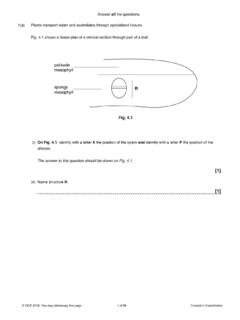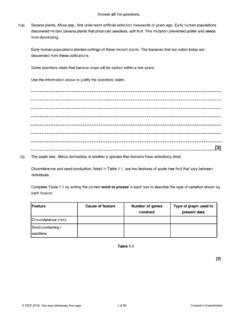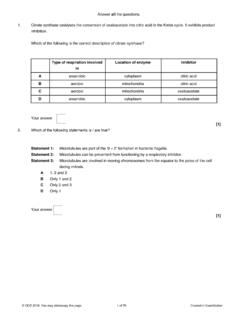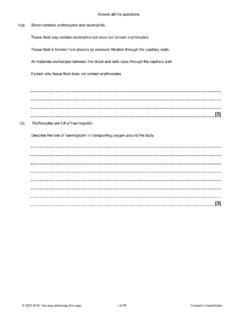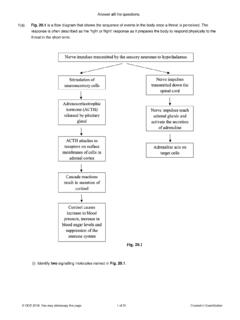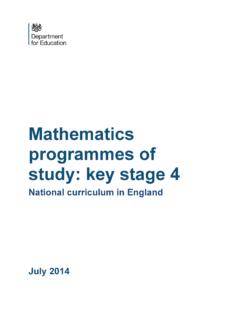Transcription of How to Answer the GCSE Questions - Calder Learning Trust
1 How to Answer the gcse Questions Question types 2 x MCQ's (1 mark each) Colour in the correct circle for the correct key term. Describe (3 marks) Describe means WHAT. Identify and describe (3 marks) [Identify and] describe Show good knowledge and understanding of relevant sociological theories, concepts, evidence and methods From Item examine (research Examine one [strength/weakness] from research identify a relevant methods strength and point and briefly say why it is a strength or weakness weaknesses question) (2 marks). Identify and explain one (related Write one paragraph in which you identify the point clearly [1 mark]. to item and research method) (4 and then give a detailed and well developed explanation of relevant marks) sociological theories, concepts, evidence and methods relevant to question.
2 Make sure you apply this information by linking it to the context of the question/item given [3 marks]. Identify and explain one You identify say a strength/weakness and explain why it is a (Methods in context) (4 marks) strength/weakness for the context it has given you. You must refer it to the context in your Answer From item identify and describe Identify and describe what it is asking you to do from the item. Then (Key study) (4 marks) you need to say what else you know. Where appropriate you should say which perspective they come from (Functionalist/Marxist/Feminist etc.). Essentially the second part of the question is wanting you to show what else you know about the study/theory beyond what the question/item gives you.
3 Identify And explain how Identify and explain relevant [sociological concept]. you would investigate it using (research methods and You must link these to the given context; use the context in your context) (4 marks) Answer . Or Identify and explain one (4. marks). Point- You should start each paragraph by making your point. Discuss how far sociologists Evidence- State an example to support your point, it gives weight to (12 marks) X 2 your argument and makes your point stand out. This could be a study/a theory/ statistics /a researcher etc. Explain- You now need to explain your point and your evidence in relation to the question.
4 Evaluate- You now need to criticise the point above. Link- Link your all of the above back to the question. It is essentially a mini conclusion. Conclusion- Write a justified conclusion that answers the question. Describe means WHAT. Explain means WHY. Practice Exam Questions for Family: 3, 4 and 12 Markers Family: 3 Markers Identify and describe one example of how patriarchy can affect the power relationship within families. Identify and describe one example of how patriarchy can affect the power relationship within families. Describe how the domestic division of labour may be organised in families. Identify and describe one type of family diversity identified by the Rapoports.
5 Family: 4 Markers Identify and explain one factor that may have led to an increase in the number of children raised in single-parent families referred to as a concern in Item A. (Specimen 1). Identify and explain one advantage of using unstructured interviews to investigate relationships between family members. (Specimen 1). From Item B, identify and describe the research method used by the Rapoports including what you know of their perspective on the family. (Specimen 1). Identify one function of the family and explain how you would investigate this function using questionnaires. (Specimen 1). Describe the type of statistical data shown in Item A.
6 Identify the trend shown by the data and explain one factor which may account for this trend. (Specimen 2). Identify and explain one advantage of using postal questionnaires to investigate the domestic division of labour within families. (Specimen 2). From Item B, identify and describe one way in which Delphy and Leonard believed that the family could be patriarchal, including what you know of their sociological perspective on family. (Specimen 2). Identify one ethical issue that you would need to consider when investigating the domestic division of labour and explain how you would deal with this issue in your investigation. (Specimen 2).
7 Family: 12 Markers Discuss how far sociologists would agree that marriage is no longer seen as important in modern British society. Discuss how far sociologists would agree that changing social attitudes are the main reason for changes in the divorce rate over the past 50 years. Discuss how far sociologists would agree that there is no longer a typical family in Britain. Discuss how far sociologists would agree that gender roles within families have changed considerably over the last 50 years. Discuss how far sociologists would agree that families remain an important agency of socialisation in Britain today. Discuss how far sociologists would agree that the extended family is becoming less significant in society today.
8 Discuss how far sociologists would agree that the changing social position of women is the main reason for the changes in the divorce rate in the past 50 years. Discuss how far sociologists would agree that the nuclear family is the best type of family in which to socialise children in modern Britain. Discuss how far sociologists would agree that changes in the status of women in society are the main reason for the pattern of divorce in Britain since 1945. Discuss how far sociologists would agree that the family has lost its importance in Britain today. Discuss how far sociologists would agree that feminism has changed marriage in modern British society.
9 Discuss how far sociologists would agree that in Britain today social classes have different experiences of family life. Discuss how far sociologists would agree that families are the main agent of socialisation. Discuss how far sociologists would agree that marriage is still important in Britain today. Practice Exam Questions for Education: 3, 4 and 12 Markers Education: 3 Markers Describe the hidden curriculum in education. (Specimen 1). Identify and describe one example of the cultural capital which middle class parents can use to give their children advantages at school. (Specimen 1). Describe a home-based factor that could influence a student's educational achievement.
10 (Specimen 2). Identify and describe one example of a type of secondary school in Britain today. (Specimen 2). Education: 4 Markers Identify and explain one alternative factor that may have led to the relatively poor performance of working class pupils referred to as a concern in Item C. (Specimen 1). Identify and explain one disadvantage of using questionnaires to investigate the literacy skills of parents.(Specimen 1). From Item D, identify and describe the research method used by Willis including what you know of his perspective on education. (Specimen 1. Identify one possible label that might be attached to students who fail to conform and explain the possible impact that label might have on their school career.)
